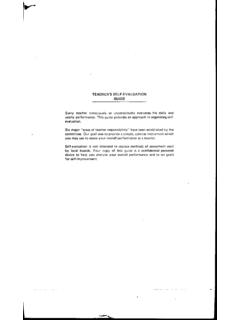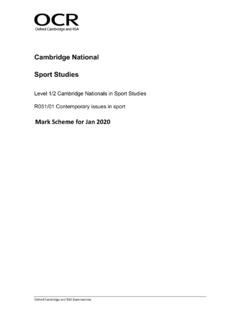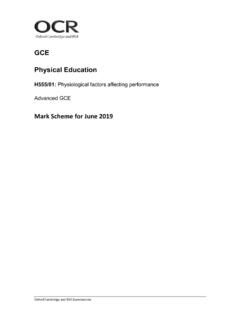Transcription of Differential Aptitude Test (D.A.T.s)
1 An Aptitude test is an instrument used to determine and measure an individual s ability to acquire, through future training, some specific set of skills. There are several Aptitude tests on the market, and the one chosen is called the Differential Aptitude Test. This test covers several areas including, Verbal Reasoning, Numerical Ability, Abstract reasoning, Perceptual Speed and Accuracy, Mechanical Reasoning, Space Relations, Spelling, and Language Use. The tests are performed under exam conditions and are strictly timed. All questions have a definite right or wrong answer. Very few candidates usually complete the entire test and the questions usually become progressively more difficult. The test is also age related. These tests can be used to help an individual 1. Chose among educational and career options based on strengths and weakness 2.
2 Help an individual understand why they do well or poorly in certain subjects. 3. Can suggest new career options not previously considered. 4. Change or raise educational and career aspirations. They cannot however, pinpoint one specific career or one specific subject that an individual should pursue. All test of this nature should be viewed with extreme caution. Under no circumstance should the score be interpreted as final indisputable evidence of an individual s characteristics. The results provide only one small part of the information needed to help an individual make informed and realistic decisions and cannot be judged in isolation from other aspects of a persons character including, job and other experiences, interests, goals, personality, values, family and environmental influences. Other factors that can also influence an individual s scores are; a hearing, visual, or physical disability or a poor command of English, as well as poor health or fatigue or an emotional disturbance on the day.
3 In addition, an individual can lose his place on the answer sheet or may simply not be interested in cooperating with the exercise, or indeed, may simply be in bad humour on the day. Finally, it needs to be remembered that an individual can have an Aptitude for a particular area but have no interest in it, and conversely, may have a low Aptitude in area a have an extreme interest or liking for it. Percentile and Stanine When an individual takes a test the results a produced are raw scores. For example, if a candidate scores 17 in a test it has very little meaning unless it know how this score relates to the total possible score. It is common therefore, to convert scores to percentages as this gives an indication as to how the candidate performed relative to a total possible score. However, percentages can themselves be misleading. For example, if a candidate scores 90% in a test, this might seem to be a very good score, but, if all the other candidates score 95%, this puts a different perceptive on this score of 90%.
4 Therefore two systems are used to convert raw scores to a system that gives meaning to the result in terms of (i) the total possible score, (ii) the score relative to the score obtained by other candidates. These two systems are referred to as, percentiles and stanine. A percentile score indicates the percentage of candidates who fall below a particular raw score. A score, which falls at the 65th percentile, means that an individual s score Differential Aptitude Test ( ) is better than 65% of the students. A 95th percentile score means that an individuals score is greater then 95% of the students, or, that this student s score is in the top 5% of students. Stanine scores is a range expressed as a series of single digits numbers between 1 and 9, were 4 to 6 represents an average score. Percentile scores can be used in conjunction with stanine score as outlines below.
5 Verbal Reasoning This test measures the ability of a student to see relationships among words. The test consists of analogies. For example: ..is to bark as cat is to .. Select one of the following answers. A maiow ------- kitten B dog --------miaow C dog ------scratch D seal -------- kitten E tree -------- Scratch This test assesses the ability to infer the relationship between the first pair of words and apply the relationship to the second pair of words. Verbal reasoning may be useful in helping to predict success in academic courses as well as in occupations where accurate communication is important. This includes business, law, education, marketing, public relations, the arts, and journalism. It has particular relevance for English, Irish, and other languages, as well as History. In these areas of study a great deal of reading is involved.
6 Those with well-developed verbal reasoning will usually be good at finding the words to explain ideas and will be able to interpret written and spoken instructions. They will also be able to absorb lectures without losing concentration or becoming confused or left behind. If a percentile in verbal reasoning is below 10, a student may be entitled to learning support from within the school. If the score is below 9 he should apply for a waver in state exams, if below 2, he should apply for resource hours. Stanine Percentile Very high 9 97 and above Above average 8 90-96 7 78-89 Average 6 59-77 5 41-58 4 23-40 Below average 3 12-22 2 5-11 Very low 1 4 and below Numerical Ability This test measures the ability to perform mathematical reasoning tasks. In order to ensure that reasoning rather than a computational facility is stressed, the computational level of the problem is low.
7 For example: 16x2 + 4y2 + 3x2 = A 19x2 + 4y2 B 19x4 + 4y2 C 23x2y2 D 23x4y2 E None of these Numerical reasoning is important for success in courses such as mathematics, physics, chemistry, accounting, actuary, economics, engineering, trades such as electrician, and carpentry as well as banking, insurance, computing, and surveying. For general business courses all of which have some mathematical component good numerical reasoning can prove valuable. Those with high numerical reasoning will enjoy using numerical/statistical data and use these creatively and accurately. The numerical score alone is not enough to predict ability in honours Maths which also requires a high level of abstract reasoning Abstract Reasoning This test is a non-verbal measure of reasoning ability. It assesses how well individuals can reason geometric shapes or design.
8 Each test item is a geometric series in which the elements change according to a given rule. The student is asked to infer the rule/s that are operating and predict the next step in the series. For example This type of abstract reasoning is a measure of an individual s logical, analytical, and conceptual skills. This skill is important in courses or occupations that require the ability to see relationships among objects in terms of their size, shape, position, and quantities, and where the ability to analyse dynamic changes and project them forward in time. Examples include mathematics, computer programming, architecture, and mechanics, as well as law, medicine and economics. It is also useful in courses such as economics that requires an individual to envisage cause and effect in situations were it is important to predict the future based on past events and trends, for example, market trends in the financial sector.
9 Individuals with good abstract reasoning will usually work out problems for themselves and will often challenge ideas that fail to be convincingly though through or explained. Problem Figures Answer Figure Select the next figure in the sequence | || ||| |||| |||| |||||| ||| |||||||| ||||| A B C D E Perceptual Speed and Accuracy This test measures the ability to compare and mark written lists quickly and accurately. This test may predict success in certain kinds of routine clerical tasks, such as filing and coding. Good scores are also desirable for certain jobs involving technical and scientific data.
10 Example: The following list is given to the student. The list is then repeated on the answer sheet. The student is instructed to mark off the underlined combination on a separate answer sheet. A AB AC AD Ae AF B aA aB Ba BA Bb C A7 7A B7 7B AB This Aptitude tests can also be used to predict hand eye coordination and is carried out under strict time conditions. A high score can be useful in areas such as secretarial work, administration, pilot, computing, accounting, and finance related areas. Mechanical Reasoning This test measures the ability to understand basic mechanical principles of machinery, tools, and motion. Each item consists of a pictorially presented mechanical situation and a simply worded question. Items require reasoning rather than special knowledge. Example: When the handle is moved in the direction of the arrow, in which direction will the paddle turn, A or B.




